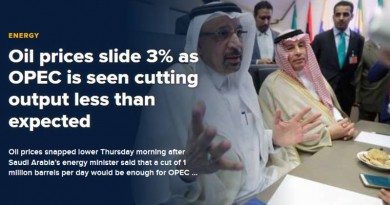What the Rise of the Yuan Means for the Global Economy
With China’s yuan taking the biggest step yet toward joining the dollar and euro as a top-rank reserve currency, the global economy may be approaching an era of greater stability.
So say economists who highlight the dollar’s role in the biggest financial crises in recent decades. Drawn to the liquidity and security of the unit of the world’s biggest economy, investors and governments relied on the dollar and produced dislocations including historically low borrowing costs in the 2000s even as the Federal Reserve raised interest rates.
Rushes toward the safety of the dollar challenged global policy makers in 2008 as money markets seized up, prompting the Fed to open swap lines with counterparts that remain in place today. China responded in 2009 with a call for reducing reliance on the dollar, with central bank Governor Zhou Xiaochuan floating the idea of a “super-sovereign” reserve currency.

While the proposal fell flat, Zhou and his allies began a campaign to win inclusion for the yuan in the International Monetary Fund’s special drawing rights unit. The SDR, as it’s called, is a kind of overdraft account for members of the IMF, convertible into dollars, euros, pounds and yen. The Washington-based fund’s staff said Friday that the yuan has now met the qualification terms for inclusion in the SDR.
Dollar Dangers
“The current configuration of the global monetary-financial system that is centered and increasingly dominated by the dollar is not a stable or a sustainable one,” Stephen Jen, co-founder of SLJ Macro Partners LLP in London and a former IMF economist, wrote with colleague Joana Freire last week.
Some 87 percent of foreign-exchange trading involves the dollar, the most recent survey by the Bank for International Settlements showed. “The role of the U.S. dollar as the world’s dominant vehicle currency remains unchallenged,” the BIS said in 2013, noting that the euro had declined in the wake of the European debt crisis.
With the world’s second-largest economy and as the number-one trading nation, China may offer the global system a currency that can complement the dollar. For now, restrictions on the ability to take money in and out of China, and on what foreign investors can buy, mean the yuan’s role will be limited.
Coming Inflows
Winning official reserve-currency status still needs approval by the IMF’s executive board, with implementation coming in late 2016. Treasury Secretary Jacob J. Lew told Chinese Vice Premier Wang Yang while attending a Group of 20 gathering Sunday that the U.S. intends to support SDR inclusion as long as the yuan meets existing IMF criteria.
The move will spur global central banks and sovereign wealth funds to put about $350 billion into the Chinese bond market over a five-year period, according to JPMorgan Chase & Co. That’s still a fraction of the $1.27 trillion worth of Treasuries officially held by China.
Building on the SDR achievement to become a true international currency for funding and investing, along the lines of the euro and dollar, may take much longer. China faces questions about rule of law, with the nation’s judicial system subject to oversight by the Communist Party.
“China needs to develop and demonstrate more ‘soft power’ in order to persuade the world to hold its assets and its currency,” Jen wrote. That is “measured by a general sense of admiration and trust from global investors, is more difficult to build and demonstrate.”
Credibility Hit
The country’s regulators took a hit to credibility when they expressed little concern for a speculation-driven surge in the stock market early this year, only to intervene with a rush of emergency measures when equities crashed over the summer.
Another surprise to financial markets was a devaluation of the yuan in August, described as a shift toward a more market-driven exchange rate. A surge in selling pressure then triggered intervention to prop up the yuan, causing a slide in foreign-exchange reserves.
The yuan would become “the first developing country currency” with reserve status, said Daili Wang, a Singapore-based economist at Roubini Global Economics LLC. “This may increase instability to the international monetary system, as we saw after the RMB FX reform in August,” he said, using the initials for renminbi, another term for China’s currency.
Reform Plans
Zhou and his reformist allies have moved to open up China’s financial markets and reduce the state’s role in setting lending rates and returns on savers’ deposits. President Xi Jinping and Premier Li Keqiang have championed a new five-year plan that aims to put flesh on the bones of a 2013 commitment to increase the role of market forces in China’s economy.
“The yuan’s contribution to international economic stability — whether to enhance it or to undermine it — will depend on the China’s economic stability at home,” said Daniel Rosen, a partner at Rhodium Group LLC, a New York economic-research firm that specializes in China. “If Beijing can stay on track with wrenching market reforms over the coming 24 months, including state-enterprise reform and major opening to imports and investment from abroad, then positive expectations for the yuan’s role will be well-founded.”
China is pursuing other initiatives to enhance its currency’s role, including through the establishment of the Asian Infrastructure Investment Bank and the Silk Road initiative of strengthening land and sea links with central and southeast Asian nations.
‘Profound Impact’
“RMB’s SDR inclusion will have a profound impact on the global financial market and the international monetary order,” said Jian Chang, chief China economist at Barclays Plc in Hong Kong, who previously worked at the World Bank. Along with capital-market opening and the Silk Road plans, it will lead to “much greater use of the currency in both trade and financial tractions globally in the medium term,” she said.
For now, the global economy is stuck with a dollar-dominant system, with the spotlight on how the U.S. central bank will conduct its shift toward raising interest rates. Past episodes of Fed policy shifts have had ripple effects across international capital markets — including the 2013 “taper tantrum,” where indications of an end to quantitative easing touched off slides in emerging-market currencies.
“The renminbi’s rising status as an international currency will help to transform the current international monetary system into a more multi-polarized system,” Shen Jianguang, chief Asia economist at Mizuho Securities Asia Ltd. in Hong Kong, wrote in a note last week.




